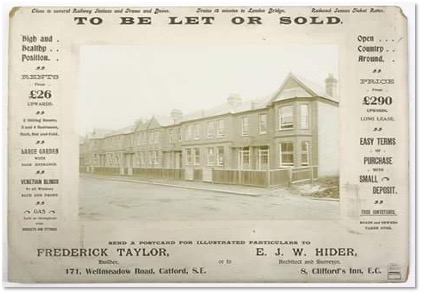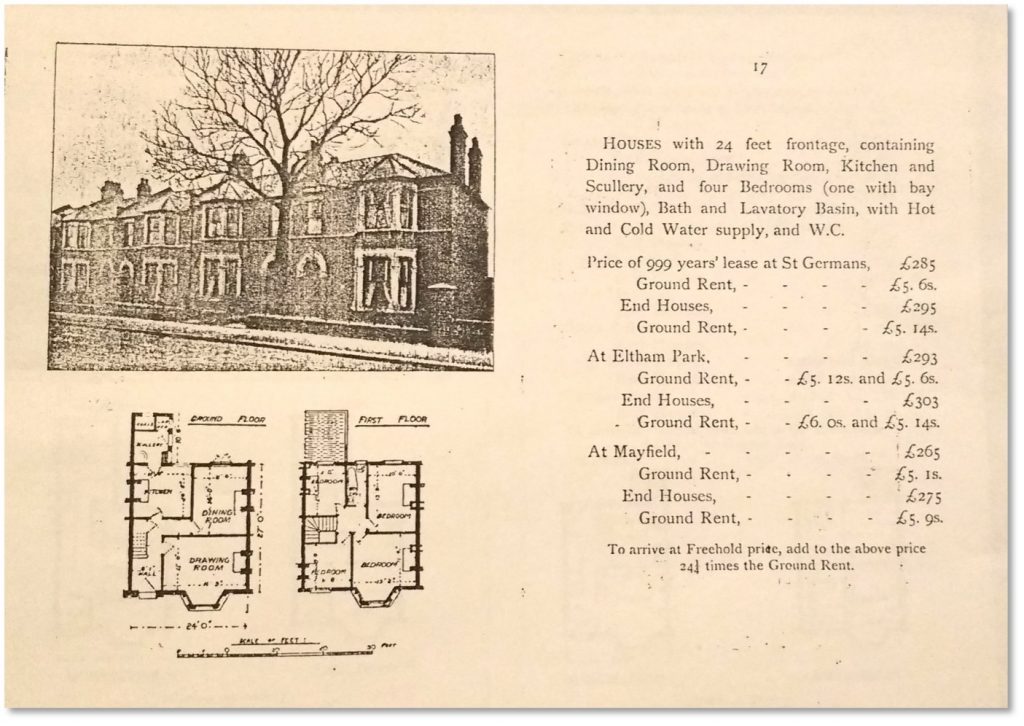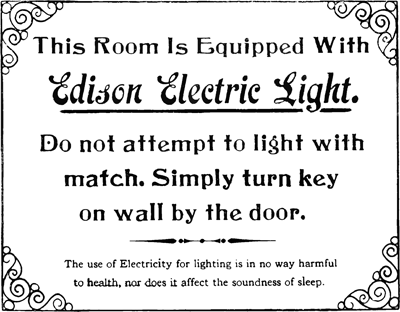“A Royal Connection”
Birkhall road lies in the south of the Corbett Estate, and was built in 1904/5, just over halfway through the 15 years it took to finish all 27 streets. The name refers to a huge estate and mansion house in Scotland: ‘Birkhall’ is probably best known as the home of the late Queen Elizabeth the Queen Mother in Aberdeenshire. It is now owned by the Duke and Duchess of Rothesay (the Scottish identities of the Prince of Wales and Duchess of Cornwall). In Scots the name literally means Birch River Meadow (Birk Hauch).
There are two distinct styles of house: the ‘heavier’ Gothic-influenced ones, with carved capitals at the top of stone mullions, and often with distinctive Corbett Keystones; and a ‘lighter’ design with an all-brick façade. The first were the work of Catford builder James Watt, who built around a third of the Estate, and the second were built by Frederick Taylor, who lived in Wellmeadow Road as this flyer shows.

Just-built homes advertised for sale on the eastern side of Birkhall Rd, built by Frederick Taylor
The Early Residents: details from the 1911 Census
By 1911 when the Census was taken, 376 people lived in the street’s 94 houses, with just four of them having more than one Head of Household (ie the house had been split in two – often one generation of a family lived upstairs and another downstairs).
The residents of Birkhall enjoyed the lowest average density of people per house across the whole estate: 3.8 people. This is in stark contrast to nearby Sandhurst Road where the figure was 6.2, and the houses were smaller! There were a couple of properties with 9 people in them (7 children and 2 adults), at Nos. 4 and 36, but they were very much the exception. There were no lodgers in the whole street, and 7% of households had a servant.

Homes built by James Watt, identical to those on Birkhall Road, in the Estate Sales Brochure
In terms of jobs, the street had one of the highest concentrations of the most popular form of work on the Estate: 31% of working people were Clerks. Across the 27 streets, the average figure is 20%. The next most popular professions were Teachers, Dressmakers and Telephone operators.
The oldest resident was Elizabeth Walker at No. 69 – she was 83 in 1911.
Birkhall boasted three of the best job titles on the whole estate: James Knights, age 35, was a ‘Traveller Artificial Manure Manufacturer’ at No. 26; Ernest Bridal (at 18 the eldest of five sons to Caroline and Ernest Bridal at No. 4) was an ‘Electric Light Attendant’; and William Woole, 34, was a ‘Boot Clicker’ living at No. 20 with his brother George and George’s family. Boot Clickers cut leather for shoes against a metal mould, and their knives made a clicking sound as they worked.
HISTORICAL CONTEXT: Electricity
Ernest Bridal (the young man at No. 4) was at the cutting edge of early 20th century technology in his job of Electric Light Attendant. The Estate was heated and lit by gas and coal, so it’s likely he worked in Lewisham or Catford. In 1910 only 2% of homes in the country had electricity.
There was distrust for the new-fangled electric devices, and they were very expensive – hence why it might be necessary to have someone to ‘attend’ to them.

Advert for Edison lightbulbs
It was only after the First World War that homes started to be wired for electricity on a large scale. An Electricity (Supply) Act was passed in 1926, which led to the establishment of a National Grid.
Interestingly, and contrary to popular opinion, the light bulb wasn’t invented by Thomas Edison, but by a man called Humphrey Davy, back in 1806. But Davy’s Arc Lamp was blindingly bright and totally impractical. Joseph Swan from Sunderland made it much more practical, and he eventually went into partnership with Edison, who was a very skilled promoter of the new technology.